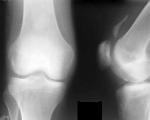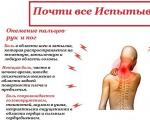Types of ankle fractures and their treatment
An ankle fracture is a violation of the structural integrity of the bones of the distal (farthest from the body) section of the lower leg. In everyday speech, the ankle is called the ankle. This anatomical formation consists of:
- The lateral malleolus, that is, from the distal tibia, which performs the function of holding the ankle joint in the correct position.
- Medial malleolus, that is, from the bone process of the tibia.
Another name for the lateral malleolus is the outer one, and the medial malleolus is the inner one. It is the ankle that is involved in the transfer of the weight load to the foot, so it is equipped with a powerful articular-ligamentous apparatus. Visually, the ankle looks like small bony bumps located almost symmetrically outside and inside the foot. The ankle joint moves only in one plane, so an ankle fracture is often combined with a dislocation or.
Ankle fractures and their classification
All fractures are divided into two groups based on the integrity of the skin. If the integrity is broken, that is, an open wound has formed, containing bone fragments, this is. If the soft tissues do not communicate with the environment, this is a closed fracture.
 Closed fractures can be complicated by internal damage to blood vessels, muscles, ligaments, and joints. Sharp bone fragments, moving, can cut and rip any type of tissue, causing significant damage to the body. That is why it is important not to allow movement in the affected limb.
Closed fractures can be complicated by internal damage to blood vessels, muscles, ligaments, and joints. Sharp bone fragments, moving, can cut and rip any type of tissue, causing significant damage to the body. That is why it is important not to allow movement in the affected limb.
With open fractures, bleeding opens, and with closed fractures, hemorrhage occurs either under the skin or in layers of other soft tissues. In the ankle area there are a large number of vessels, joints and nerve endings that will need to be restored after an injury.
From 10 to 15% of the victims receive a disability, because they cannot fully return all the functions of the ankle.
The two bumps on the sides observed when looking at the foot are the ends of the fibula and tibia.
And between them below is a block of calcaneal bones, talus, cuboid, scaphoid and others. Due to the specific features of the articulation, a combined fracture of the ankle and any of the heel bones very often occurs. What causes fractures? Due to their occurrence, they are:
- Pathological, fatigue or provoked internal diseases, for example, osteoporosis, malignant or benign neoplasms, tuberculosis.
- Traumatic, that is, resulting from a fall, impact, crushing of the ankle bones.
The fundamental difference between these two categories is that they can arise almost spontaneously, they do not require any special stimulus from the outside world. Due to age-related fragility of bones, even with minimal impact, a fracture can occur, which leads to a large percentage of injuries among the elderly. In older people, bone tissue regeneration is generally slower than in younger people, so rehabilitation becomes longer. According to the degree of violation of the integrity of bone tissues, ankle fractures are: 
- complete, that is, the bone is divided into two or more separate bone fragments;
- incomplete, that is, a crack passes between the bone fragments.
The composition of the ankle includes only the small and large tibia, but also the talus, located below. A bimalleolar fracture is different in that it only involves the tibia, while a trimalleolar fracture also involves the talus. According to the degree of remoteness from each other of bone fragments, the following can occur:
- Displaced ankle fracture, when bone fragments break through the periosteum and change their position relative to each other.
- Fracture of the ankle without displacement, when the bones do not leave the space of the periosteum.
The most common cause of ankle injury is a fall on the foot with a twisted foot. A person who has trained muscles and strong bones will receive a minor injury in this case, but with weak muscles and fragile bones, a trimalleolar fracture with subluxation may occur. In order to reduce the likelihood of such injuries, you need to use shoes with non-slip soles, be vigilant and step on the ground carefully. With any fracture, first aid plays an important role. The speed of recovery often depends on how competently it is provided.
Fracture symptoms and first aid
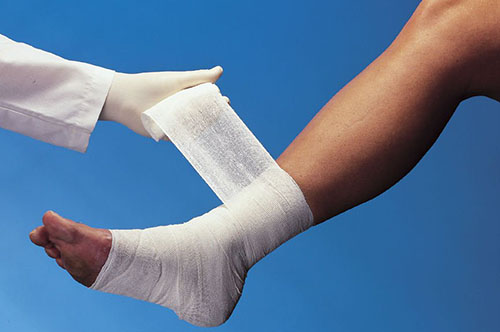 The diagnosis is made on the basis of X-ray examination only after arrival at the emergency room. Signs of an ankle fracture:
The diagnosis is made on the basis of X-ray examination only after arrival at the emergency room. Signs of an ankle fracture:
- the victim feels a sharp pain at the site of injury;
- sometimes a loud crunch of breaking bones is heard;
- it is difficult to use the leg as a support, it is impossible to walk;
- swelling forms in the lower part of the leg, which sometimes reaches the very toes;
- the color of the skin changes, hemorrhage occurs, a hematoma occurs, which gradually shifts down;
- visually, you can observe the deformation of the joint of the lower leg and foot, bending at an unnatural angle;
- in the case of an open fracture, a wound with noticeable bone fragments is formed, with a closed fracture with a displacement, the bone fragments can bulge, stretching the skin;
- the skin below the injury site turns pale, sensitivity may be disturbed, numbness or tingling occurs;
- the toes and ankle joint lose some of their functions, the victim cannot move his toes.
Features of innervation are individual for everyone, so incomplete without displacement can bring some people some minor pain. If you suspect a fracture, you should immediately contact the emergency room. Open fractures are always painful. The victim will be forced to seek medical attention in time. An ambulance should be called immediately. Pain can be reduced by: 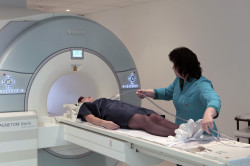
- Drink a non-narcotic pain reliever from a home, sports, camping or car first-aid kit with water, tell the ambulance team the name of the medication and the dosage of the dose.
- An ice compress from improvised materials (apply for 15 minutes, take a break of 5 minutes, prevent condensate and melted water from draining into the wound, lay a tissue between the ice and the skin).
The injured limb cannot be moved. If the person providing first aid has the skill of splinting, this can be done. But if there is no such skill, it is better not to train.
Incorrectly rendered first aid greatly complicates the work of a traumatologist and increases the process of fracture healing. More than 8 ligaments are located in the joint capsule of the ankle, damage to any of them is very dangerous for the subsequent walking of a person.
Also in the ankle joint are seven tendons that are very important for controlling the limb. During first aid, you can move the victim only if being in place poses a threat to life. In all other cases, you need to wait for the ambulance.
Health care
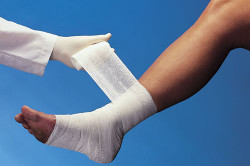 Sometimes the pain is so intense that pain relief is required immediately. The first aid kit contains all the necessary narcotic and non-narcotic analgesics to alleviate the patient's condition. The choice is made depending on the severity of each specific case, as a rule, multiple injections of Novocain are carried out around the site of injury (this method is called blockade). After that, the victim is taken to the emergency room, where the diagnosis is made on the basis of:
Sometimes the pain is so intense that pain relief is required immediately. The first aid kit contains all the necessary narcotic and non-narcotic analgesics to alleviate the patient's condition. The choice is made depending on the severity of each specific case, as a rule, multiple injections of Novocain are carried out around the site of injury (this method is called blockade). After that, the victim is taken to the emergency room, where the diagnosis is made on the basis of:
- x-ray examination;
- computer and magnetic resonance imaging.
Radiography is performed in direct, oblique and lateral projections to clarify the positions of all bone fragments. Correct repositioning is based on complete clarity of the clinical picture of the injury. Of particular difficulty are compression fractures of the ankle, when the distal extremities of the femur and metatarsal bones are crushed to the smallest fragments. This kind of picture can be observed after crushing the leg as a result of falling from above very heavy and dimensional objects, for example, pieces of rock during a collapse.
A displaced fracture of both ankles will necessarily require magnetic resonance imaging to assess the degree of damage to the articular-ligamentous apparatus.
Ankle fracture: treatment and recovery
 Treatment can be conservative or surgical (depending on the severity of each specific case). Conservative consists in applying a cast, taking painkillers, anti-inflammatory drugs and stimulating the growth of bone tissue. A conservative approach is most often chosen for the following fractures:
Treatment can be conservative or surgical (depending on the severity of each specific case). Conservative consists in applying a cast, taking painkillers, anti-inflammatory drugs and stimulating the growth of bone tissue. A conservative approach is most often chosen for the following fractures:
- a fracture of the external malleolus without displacement is managed by conservative treatment;
- a fracture of both ankles at once without displacement undergoes conservative treatment;
- a fracture of the medial malleolus without displacement is treated conservatively.
Conservative treatment without reposition takes place only with closed injuries, when the position of the bone fragments is anatomically correct. Surgical treatment involves the following fractures:
- a displaced fracture of the medial malleolus requires surgical intervention;
- a displaced fracture of the lateral malleolus is treated operably;
- surgery is indicated if an open fracture of the ankle is diagnosed.
To control successful reposition, radiography is again performed, and only after that the entire back surface of the lower leg and foot is immobilized. To accelerate healing, fixation of bone fragments with the help of special structures is used, otherwise the fracture heals for a long time.
With unsuccessful healing, the following complications are possible:
- chronic diseases of the articular surfaces of the tibia and talus, arthrosis of the ankle joint;
- false joint at the site of injury;
- violations of muscle control over the limb, neurological disorders;
- thrombosis of the veins of the foot, vascular disease.
Inner ankle injury
A fracture of the medial malleolus can lead to lameness and chronic joint pain due to improper weight distribution on the arch of the foot. The treatment must necessarily include physiotherapy procedures for pain relief and speedy recovery. Often the causes of a fracture lie in metabolic disorders, in calcium deficiency in the body. Electrophoresis with calcium and hydrocortisone preparations shows its effectiveness. The victim is assigned the following procedures:
- exposure to interference currents;
- ultraviolet irradiation;
- magnetic therapy;
- laser therapy;
- the use of ultra-high frequencies;
- ultrasound.
A simple fracture of both ankles heals in two weeks to two months. More complex cases are treated depending on the severity and rate of bone regeneration. Muscle tension without movement and exercises to develop the ankle joint are prescribed by the attending physician as treatment progresses. During the entire time of wearing the cast, the victim moves with the help of crutches. The diet should be adjusted in such a way that it contains a lot of mineral trace elements, calcium and magnesium. The victim is assigned a calm regime of the day, a lot of sleep and rest. To prevent painful complications, it is necessary to responsibly treat all the recommendations of the attending physician, carry out the treatment of an ankle fracture prescribed by him, and perform physical therapy exercises.


